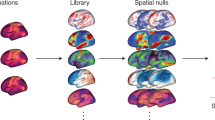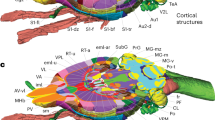Abstract
The Mouse Atlas Project (MAP) aims to produce a framework for organizing and analyzing the large volumes of neuroscientific data produced by the proliferation of genetically modified animals. Atlases provide an invaluable aid in understanding the impact of genetic manipulation by providing a standard for comparison. We use a digital atlas as the hub of an informatics network, correlating imaging data, such as structural imaging and histology, with text-based data, such as nomenclature, connections, and references. We generated brain volumes using magnetic resonance microscopy (MRM), classical histology, and immunohistochemistry, and registered them into a common and defined coordinate system. Specially designed viewers were developed in order to visualize multiple datasets simultaneously and to coordinate between textual and image data. Researchers can navigate through the brain interchangeably, in either a text-based or image-based representation that automatically updates information as they move. The atlas also allows the independent entry of other types of data, the facile retrieval of information, and the straight-forward display of images. In conjunction with centralized servers, image and text data can be kept current and can decrease the burden on individual researchers’ computers. A comprehensive framework that encompasses many forms of information in the context of anatomic imaging holds tremendous promise for producing new insights. The atlas and associated tools can be found at http://www.loni.ucla.edu/MAP.
Similar content being viewed by others
References
Bard, J. L., Kaufman, M. H., Dubreuil, C., et al. (1998) An internet-accessible database of mouse developmental anatomy based on a systematic nomenclature. Mech. Dev. 74, 111–120.
Bota, M. and Arbib M. A. (2002) The Neurohomology database: An online-KMS for handling and evaluation of neurobiological information, in A Practical Guide to Neuroscience Databases and Associated Tools. (Kotter, R., ed.) Kluwer Academic Publishers, Boston, MA. pp. 203–220.
Bota, M., Dong, H. W., and Swanson, L. (2003) From gene networks to brain networks. Nat. Neurosci. 6, 795–799.
Bowden, D. M. and Martin, R. F. (1995) NeuroNames Brain Hierarchy. Neuroimage 2, 63–83.
Carson, J. P., Thaller, C., and Eichele, G. (2002) A transcriptome atlas of the mouse brain at cellular resolution. Curr. Opin. Neurobiol. 12, 562–565.
Franklin, K. B. J. and Paxinos, G. (1997) The Mouse Brain in Stereotaxic Coordinates, Academic Press, San Diego.
Gallyas, F. (1979) Silver staining of myelin by means of physical development. Neurol. Res. 1, 203–209.
Ghosh, P., O’Dell, M., Narasimhan, P. T., Fraser, S. E. and Jacobs, R. E. (1994) Mouse lemur microscopic MRI brain atlas. Neuroimage 1, 345–349.
Hof, P. R. and Young, W. G. (2000) Comparative Cytoarchitectonic Atlas of the C57BL 6 and 129 Sv Mouse Brains, Elsevier, Amsterdam.
Kahn, M. A., Kumar, S., Liebl, D., Chang, R., Parada, L. F., and De Vellis, J. (1999) Mice lacking NT-3, and its receptor TrkC, exhibit profound deficiencies in CNS glial cells. Glia 26, 153–165.
Nicolelis, M. A., Tinone, G., Sameshima, K., Timo-Iaria, C., Yu, C. H., and Van de Bilt, M. T. (1990) Connection, a microcomputer program for storing and analyzing structural properties of neural circuits. Comput. Biomed. Res. 23, 64–81.
Ourselin, S., Roche, A., Subsol, G., Pennec, X., and Ayache, N. (2001) Reconstructing a 3D Structure from Serial Histological Sections. Image Vision Comput. 19, 25–31.
Paxinos, G. and Watson, C. (1998) The Rat Brain in Stereotaxic Coordinates, 4th ed., Academic Press, San Diego.
Paxinos, G. and Franklin, K. B. J. (2001) The Mouse Brain in Stereotaxic Coordinates, 2nd ed., Academic Press, San Diego.
Rex, D. E., Ma, J. Q., and Toga, A. W. (2003) The LONI Pipeline Processing Environment. Neuroimage 19, 1033–1048.
Ringwald, M., Baldock, R., Bard, J., et al. (1994) A database for mouse development. Science 265, 2033–2034.
Rosen, G. D., Williams, A. G., Capra, J. A., et al. (2000) The Mouse Brain Library @www.mbl.org.
Shattuck, D. W. and Leahy, R. M. (2002) BrainSuite: an automated cortical surface identification tool. Med. Image Anal. 6, 129–142.
Simmons, D. M. and Swanson, L. W. (1993) The Nissl Stain, in Neuroscience Protocols, Wouterlood, F. G., ed., Elsevier, Amsterdam, pp. 93-050-12-1–93-050-12-7.
Smith, B. R., Johnson, G. A., Groman, E. V. and Linney, E. (1994) Magnetic Resonance Microscopy of Mouse Embryos. Proc. Natl. Acad. Sci. U S A 91, 3530–3533.
Stephan, K. E., Zilles, K., and Kotter R. (2000) Coordinate-independent mapping of structural and functional data by objective relational transformation (ORT). Philos. Trans. R. Soc. Lond. B. Biol. Sci. 355, 37–54.
Stephan, K. E., Kamper, L., Bozkurt, A., Burns, G. A., Young, M. P., and Kotter, R. (2001) Advanced database methodology for the Collation of Connectivity data on the Macaque brain (CoCoMac). Philos. Trans. R. Soc. Lond. B. Biol. Sci. 356, 1159–1186.
Swanson, L. W. (1998) Brain Maps: Structure of the Rat Brain, 2nd ed., Elsevier, Amsterdam.
Toga, A. W. and Thompson, P. M. (1998) Multimodal Brain Atlases, in Medical Image Databases. Kluwer Academic Press, Dordrecht, The Netherlands, pp. 53–88.
Toga, A. W., Santori, E. M., Hazani, R., and Ambach, K. (1995) A 3D digital map of rat brain. Brain Res. Bull. 38, 77–85.
Woods, R. P., Grafton, S. T., Holmes, C. J., Cherry, S. R., and Mazziotta, J. C. (1998a) Automated image registration: I. General methods and intrasubject, intramodality validation. J. Comput. Assist. Tomogr. 22, 139–152.
Woods, R. P., Grafton, S. T., Watson, J. D. G., Sicotte, N. L., and Mazziotta, J. C. (1998b) Automated image registration: II. Intersubject validation of linear and nonlinear models. J. Comput. Assist. Tomogr. 22, 153–165.




